Around Tuscany is a blog run by the Tuscan Administration, proposing travel suggestions in this region.
The blog proposed an article on the night sky in Southern Tuscany (read the post), based on material I proposed.
Around Tuscany is a blog run by the Tuscan Administration, proposing travel suggestions in this region.
The blog proposed an article on the night sky in Southern Tuscany (read the post), based on material I proposed.
At the Escola Superior de Artes e Design, in the context of a Summer School on lighting design for Erasmus students.
See the presentation (PDF, 6 Mb)
[TO BE TRANSLATED]
“…sometimes you need to be “harsh” to make sure that the law is applied” said Leopoldo dalla Gassa, the President of VenetoStellato, a non-profit association which has been active for years in the topic of light pollution in the region of Veneto, in the North-East of Italy.
by Andrea Giacomelli
AG: Leopoldo, tell us how VenetoStellato was born
LdG: In 1997 in Veneto we had our first regional law on light pollution. At that stage, several activists from the stargazing community decided to get together and evaluate the opportunities in terms of protection of their observatories. Following a series of annual meetings, in April 2000 a regional steering committee was created, and it was called Veneto Stellato (Starry Veneto).
To date we have around forty subscribers, including people from stargazing and environmental associations, are well as academic researchers and individual citizens. The average age of our members is between 35 and 40.
AG: What is your distribution in the region?
LdG: At present we have a prevaling number of members in the provinces of Verona, Vicenza, and Padova, while a smaller number comes from the Rovigo and Treviso areas. On the other hand, we are missing members in the provinces of Belluno and Venezia. Possibly the communities in Belluno are affected by the fact of being spread in mountain locations, far from the plain.
AG: This year VenetoStellato decided to support a peculiar initiative, i.e. the shut-off of lighting in Asiago, a small town in the Nothern part of the Region: tell us more about how this went.
LdG: On March 28, in the new moon phase we took part in the controlled switch-off of the city of Asiago.
[NOTE: Asiago is a town with a population around 7000, located in a highland area North of Vicenza]
The area hosts the telescopes of the Padua branch of the National Astrophysics Institute and of the Padua University.
The request for the switch-off was made by the Regional Environmental Protection Agency (ARPAV), in coordination with our permanent observatory on light pollution. This entity, which also includes VenetoStellato, has been established pursuant to the law, in order to verify the compliance to the regulations.
The initiative had the objective of raising awareness on the issue of the dispersion of light at night towards a broad audience, and to verify the impact of public lighting on night sky brightness.
Our current legislation allows the switch-off of public lighting for no more than three days per year, and always insuring safety conditions.
A report about the event (in Italian) including the recorded measurements may be downloaded from the ARPAV site.
AG: How long was the event?
LdG: The switch-off was for all of the night on March 28. In practice, all public lights were out, except for some critical roundabouts.
AG: How did the residents react?
LdG: I would like to emphasize that there were no negative reactions to the switch-off. Interestingly, some groups (ordinary citizens, not experts), arranged observation groups to look at the sky from gardens and from the city centre, in order to appreciate how the starry sky used to be years back.
AG: VenetoStellato also collaborates with ARPAV in non-compliance reports. What is the process?
LdG: As stated in the regional law, VenetoStellato, is one of the organizations acknowledged as a partner to local municipalities, providing support and suggestions in the application of the regulations.
The same organizations have the authority to report cases of non-compliance in the installation of new luminaires, and can request the adaptation of public and private installations. ARPAV receives a copy of each report and will confirm the validity of the information provided.

AG: How many reports have you produced to date?
It is difficult to provide an accurate count. I would say over two thousand, as an under-estimate, considering both public and private installations.
You should consider that each report is referred to sites, so the actual number of luminaires that we contributed to bring to compliance will be in the range of several thousands.
AG: Which are the most frequent issues?
The types of luminaires which are normally on our radar are projectors and lighting towers, since these are very often in a condition of total violation of the law.
Last, but not least,we are verifying an increasing amount of billboards, especially around shopping malls, since these happen to be one of the major source of light pollution.
AG: VenetoStellato is now in its third year of participation to the CORDILIT network, with an array of SQM stations deployed in several of the amateur observatories managed by your affiliates. Have you noticed any trend in the data?
LdG: Indeed, we use the CORDILIT data to monitor sky night brightness, observing if our reports have some impact, and also for outreach purposes.
Concerning the actual detection of trends, in order to provide an appropriate feedback we are waiting for some cross-checks which are in the process of being made both by ARPAV and by the Padua University.
What we are noting is that there is a slight variation in the dark peaks in our data. Considering the Nove station, when we installed the SQM sensor in 2011 we were never exceeding 19.8 in terms of magnitude per square arc-second. In the last 6-8 months we are consistently exceeding 20, and made it to 20.21 as the darkest reading.
On average, we have gained 0.4 on the magnitude scale: who knows how many billions of lumen we have prevented from reaching the sky!

AG: What do you see as the main threat for the protection of the night sky in our area?
LdG: The main threat for us is the proliferation of LED installations. The regional law does not prohibit their use, nor does it provide a threshold for the color temperature of the diodes.
It is possible that, if LEDs with a relevant blue light component (i.e. the devices with a color temperature above 4000K) will be adopted, just considering the components due to reflection, the amount of light pollution will be much higher than the traditional sodium lamps.
For this reason we invite administrations to adopt LED lighting with color temperature not exceeding 3000K.
AG: Which are your expectations and your goals?
LdG: Our expectations in the North-East of Italy, and especially in Veneto, is that communities will finally appreciate the amount of energy wasted for improper lighting, and that citizens will decide to fully comply to the regulatory requirements.
It is not by accident that Italy happens to be, after Spain, one of the main consumers of elecrictiy for artificial lighting in Europe….this is a record that we would really love to lose.
AG: What’s your view on the scenario in the rest of Italy?
LdG: Sadly, in the rest of the Italian peninsula there are too few organizations that are actively engaging their administrations in order to apply the existing regulations, for those regions which decided to adopt laws on light pollution. In this condition, most of the actions are left to the good will of individuals, but this is too little to provide an impact in the short term.
AG: Is there a specific anecdote related to your activity that you would like to recall?
LdG: Well, sometimes you need to be “harsh” to make sure that the law is applied. We once had a case of a municipality refusing to apply the regulations in a case related to a private installation. At that point we had to escalate the issue to the public attorney, with the request to verify the possibility of negligence in the application of the law.
At that point, it took only a couple of days for the municipality to issue their request to bring the private installation into compliance. This case did have some local media coverage, and we then started using the articles which appeared in the press as a form of persuasion with counterparts which decide to take a
“tough” approach in the interaction with VenetoStellato. They should simply understand that acting against the law is useless, and will not pay.
All images are courtesy of VenetoStellato
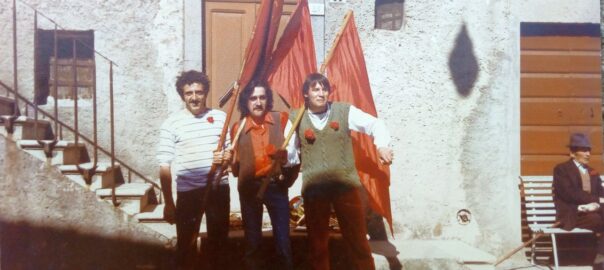
TO BE TRANSLATED ‘
Sintesi estrema di questa storia, se non avete tempo: Mariano di Scalvaia (al centro nella foto di testa) 1 – Ecosistema Culturale Nazionale 0.
Altrimenti, proseguite, sulle note dei Seguridad Social
Nel 2014 varie città italiane concorrevano per definire quale sarebbe stata la candidata a capitale europea della cultura 2019. Fu poi Matera…ma nel 2014 ancora non si sapeva, e tutte le partecipanti si davano da fare per essere le più belle, le più intellettualmente attive ecc ecc.
Nel frattempo all’epoca eravamo in pista con l’associazione Attivarti.org (ora in coma farmacologico dati gli sviluppi sulla normativa del terzo settore): stavamo organizzando la trasferta di palla a 21 a Milano e altre cose ganze. In parallelo, con la BuioMetria Partecipativa avevo da un anno il ruolo di referente per l’Italia in un progetto europeo del programma COST (cooperazione scientifica) ecc. ecc.. diciamo che sul piano culturale e scientifico, stavamo facendo il nostro, avevamo dei riconoscimenti reali, e qualche lira.
La questione della capitale della cultura mi interessava come potenziale spazio in cui proporre le nostre storie. Seguendo via via le questioni nel senese, venni a sapere che organizzavano una serie di incontri per contribuire a mettere a filo il dossier della candidatura di Siena. Uno di questi incontri aveva un titolo che dal 2020 per diverso tempo diventerà difficile usare: “Infective Roads“…la cosa era forse riferita al fatto che la cultura si può diffondere attraverso vie di comunicazione e quindi fare bene…. comunque. Rispondendo all’invito, mandai questa mail:
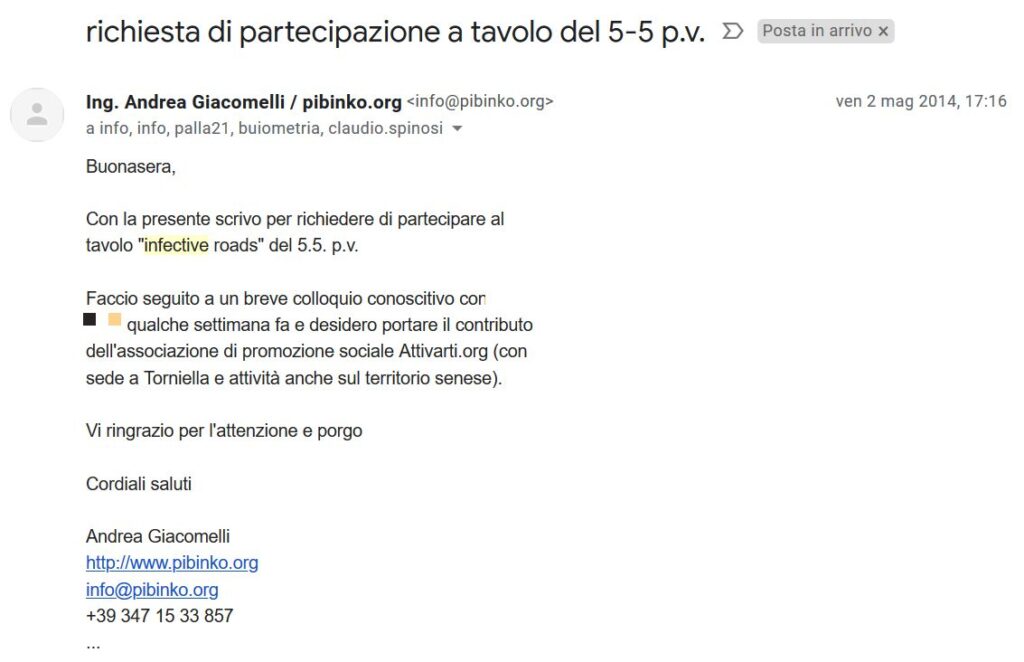
L’incontro sarebbe stato il pomeriggio di lunedì 5 maggio, in una delle sale del complesso museale di S. Maria alla Scala, il vecchio ospedale, dirimpetto al Duomo di Siena.
Mi metto in marcia da Torniella. Dopo un quarto d’oretta arrivo a Monticiano, e nella piazza principale vedo Roberto, detto Mariano, detto Sandokan, di Scalvaia, che aspettava. Mariano era uno dei coprotagonisti dei telefilm sulla palla a 21 che giravamo dal 2007. Era anche uno dei principali barzellettieri della Val di Farma (a Scalvaia organizzavano proprio a maggio la sagra della barzelletta con pranzo e a seguire sfida di barzelle fra Mariano come “resident” contro il resto del mondo, a partire da una parente di Roccastrada).
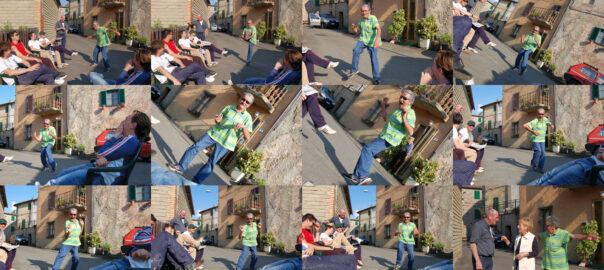
Comunque: essendo Mariano senza auto, ma con la necessità in quel periodo di recarsi nel capoluogo comunale per alcune pratiche, prendeva l’autobus della mattina per Siena. Poi sbrigava le sue pratiche, magari in mezz’ora, e dopo, essendo senza auto, a 7 km da casa e non in grandissima forma fisica, aspettava. O un passaggio di qualche conoscente (cosa non improbabile data la logistica delle valli Farma/Merse), o alla peggio l’autobus che ritornava in giù, ma dopo diverse ore.
Accosto. “Ciao Mariano, come stai?”. “Oh Andrea, ciao…che bbevi?”. …[OMISSIS]. Dopo un paio di [OMISSIS] Mariano mi chiede se gli posso dare un passaggio a Scalvaia. Gli dico volentieri, ma in effetti sto andando a Siena a una riunione ecc ecc.
Poi, saranno stati gli [OMISSIS] o uno dei momenti di linearità che si manifestano via via nelle storie della rete pibinko.org, ma faccio a Mariano una proposta. Gli spiego meglio del convegno e gli chiedo se è interessato a venire anche lui. Un’occasione per far due passi a Siena (comunque mi interessava che venisse al convegno).
Mariano non ci pensa due volte. Poi aggiunge “…ma Bob viene?”. Dico io non lo so, ma sentiamolo. Chiamo Bob. Bob era in effetti di rientro dal lavoro da uno dei suoi clienti (un personaggione con titoli nobiliari di cui avremo modo di riparlare) che vive a 2 km in linea d’aria da S. Maria alla Scala. Comunque ci dice che sarebbe venuto volentieri anche lui e di aspettarlo a Monticiano, in modo da fare una macchina sola. Nell’attesa dell’arrivo di Bob, per scrupolo, scrivo una mail alla segreteria del convegno:
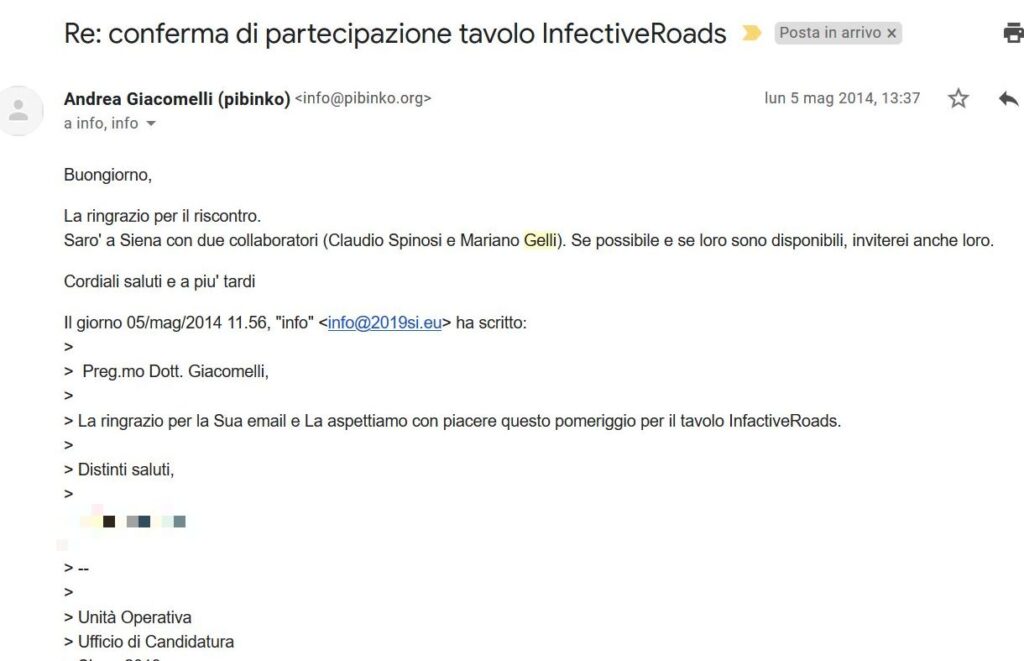
Bob arriva a Monticiano. “Ciao ragazzi, come va?”. “Che bbevi?”. [OMISSIS]. Si parte per il convegno a bordo della Lancia Y di ordinanza. Io vestito più o meno da ingegnere, Bob coi calcinacci del cantiere, e Mariano vestito da Mariano.
La risposta alla mail mi arrivò mentre eravamo probabilmente in viaggio:
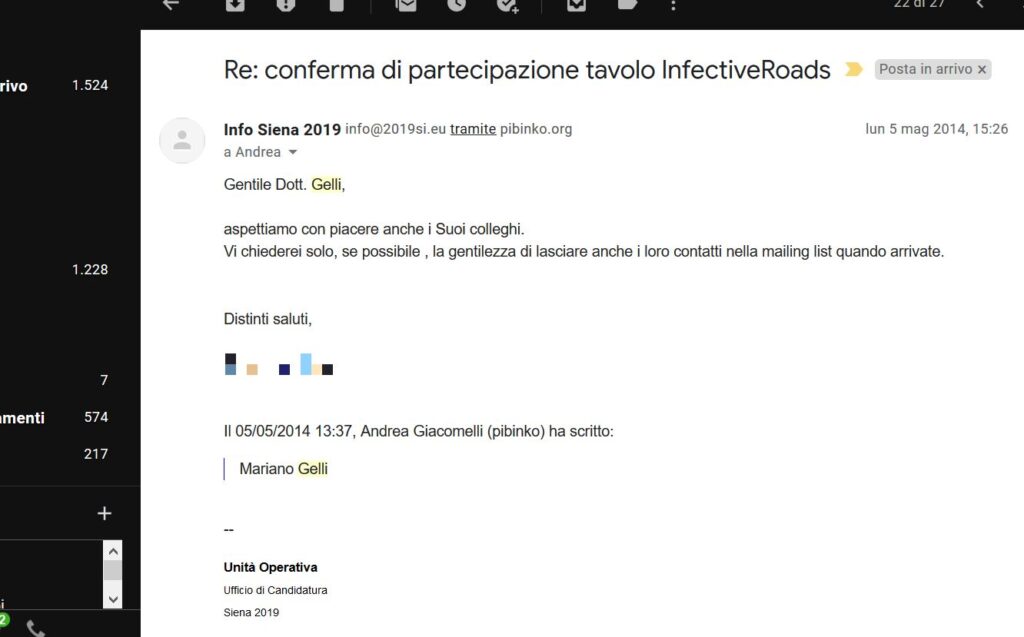
[STACCO SU PIAZZA S. MARIA ALLA SCALA, DAVANTI ALL’INGRESSO DEL COMPLESSO MUSEALE]
Bob e Mariano, davanti alla prospettiva di dover stare due ore in un ambiente dove non si può fumare, consumano quattro o cinque sigarette di fila in 5 minuti.
Entriamo, ci fanno passare per il convegno. Scendiamo varie scale. Ambiente molto suggestivo tra mura medioevali e arredi ultramoderni. Arriviamo alla sala del convegno. Circa 150 partecipanti.
Come molti eventi di questo tipo, la scaletta prevede alcuni relatori “keynote” che diano un po’ il La. Poi, se le cose sono fatte bene, esiste un criterio per proporsi per intervenire. Se no si aprono scenari di marasma comunicativo. In questo caso le cose erano fatte bene, per cui mi iscrivo per parlare e torno al mio posto. Con Bob e Mariano ci eravamo strategicamente seduti in ultima fila, in modo che loro potessero uscire per fumare.
La teoria di presentazioni si snoda fra cose più o meno interessanti e/o innovative. Mariano, che era piuttosto debole, ogni tanto si inclinava da un lato, quasi appisolandosi. Bob lo riprendeva bonariamente: “via, Roberto… “.
A un certo punto viene il mio turno, e ho i miei 5 minuti di visibilità nell’ecosistema culturale della capitale mondiale del pan pepato, del Monte dei Paschi e della Mens Sana (basket). Fra le altre cose, in riferimento a uno dei temi, che era il tenere eventi durante l’anno della cultura anche fuori Siena, ricordo di aver chiesto a quanti chilometri dalle mura prevedevano di arrivare. Non in tono polemico, ma proprio per il fatto che avevamo già fatto cose in terra senese, ma non vicino alla città, e negli anni avevano registrato una certa difficoltà a entrare in relazione con stakeholder a nord del fiume Merse, al di là di qualche scambio occasionale.
Comunque. Finisco di parlare, moderati applausi di rito, e torno al posto. Riprendono altri interventi. Mariano continua a non essere sempre vigile, non aiutato dall’atmosfera ovattata e dalle luci soffuse.
A un certo punto, va a parlare un signore vestito di nero, un po’ alla Steve Jobs, e dice “Sapete, io ho visto da poco un documentario sul Tibet. Lì facevano vedere che usano le capre per tenere puliti i giardini. Questa è una pratica interessante, di cui ci potrebbe tenere conto nell’anno della cultura a Siena, per diffonderla in vari posti ecc ecc.”. Mentre questo signore spiegava la proposta, Mariano era in uno dei momenti di veglia. appena sente dire della cosa della capra, sbotta (a voce alta, dall’ultima fila…150 persone presenti): “Eh, l’hai fatta te la scoperta! Ché, ‘un si sapeva!”. Poi si zittisce. Io e Bob lo guardiamo con un misto di sorpresa e riflessione.
Dopo un po’ decidiamo di partire: non in ritirata strategica, ma perché effettivamente abbiamo detto quello che dovevamo dire, sentito quello che dovevamo sentire, e perché non ha troppo senso far stare persone abituate a stare fuori in ambienti chiusi per troppo tempo.
Questo episodio di Mariano che risponde, magari in modo non garbato, ma “de core” all’intellettuale alla Steve Jobs che pensa di avere scoperto una pratica originale. Nel tempo è entrato nella top ten delle lezioni di relazione fra centri di conoscenza urbani e zone rurali.
Per informazioni e booking: micalosapevo@pibinko.org.
La foto di testa è di Pio Spinosi
 Tidying up some papers, we noted that on June 9, 2008, the BuioMetria Partecipativa project had its first presentation to the public.
Tidying up some papers, we noted that on June 9, 2008, the BuioMetria Partecipativa project had its first presentation to the public.
The birth was recorded (we had a videocamera) at the former Cinema Mori in Ribolla, Southern Tuscany, now hosting various civic facilities for the Municipality of Roccastrada, in addition to being one of the entry points to the Tuscan Mining Geopark.
The even had national visibility: Francesco Giubbilini, who gave the presentation, was interviewed by RAI Radio Due, and this started the participatory process which today sees the project still committed in the collection of measurements, awareness raising actions, and more issues presented through the buiometriapartecipativa.org and attivarti.org sites.
An informal recollection of what was going on in that season is available in the “brief history of BMP”, a work in progress started by pibinko in 2012, and you may check the June 2008 episode in English or Italian)
With the publication of a first semester report due in a few weeks, today we liked the idea of remembering the June 9 2008 event and to share this with you.
A summary of the meeting is on Attivarti.org (in Italian)
[TO BE TRANSLATED]
 Venerdì 30 maggio, dalle 17 alle 19 a Pistoia, nell’Atrio del Museo Marini (Corso Fedi, 72) si terrà una presentazione dal titolo “Ci rubano il cielo stellato? Tutto ciò che non si sa sulla luce artificiale di notte” a cura dell’ Ing. Andrea Giacomelli dell’associazione Attivarti.org.
Venerdì 30 maggio, dalle 17 alle 19 a Pistoia, nell’Atrio del Museo Marini (Corso Fedi, 72) si terrà una presentazione dal titolo “Ci rubano il cielo stellato? Tutto ciò che non si sa sulla luce artificiale di notte” a cura dell’ Ing. Andrea Giacomelli dell’associazione Attivarti.org.
L’intervento aprirà una tre giorni di cultura scientifica a contatto con la natura avente come tema “Sotto il cielo dell’Appennino pistoiese” e organizzata dal gruppo esperantista Umberto Stoppoloni di Pistoia, in collaborazione con Incontriamoci sull’Arno e con il patrocinio del Comune di Pistoia.
La presentazione di venerdì 30 costituisce il sesto “episodio” della campagna BuioMetria Partecipativa 2014, avviata il 19 febbraio e articolatasi sino ad ora in una combinazione di presentazioni pubbliche (Torniella (GR), Ribolla (GR) , Grosseto I , Firenze ,Grosseto II), inviti a partecipare alla versione italiana semplificata di Globe at Night, e interventi collegati alla rete europea di ricerca Loss of the Night.
Pistoia costituirà per la BuioMetria Partecipativa l’ultimo evento prima di entrare nella fase estiva della campagna, con cui dal 2008 cittadini e tecnici vengono invitati a raccogliere dati di qualità del cielo notturno e a riflettere su vari aspetti legati al tema dell’inquinamento luminoso e che ha visto sinora la partecipazione di persone da quasi tutta italia, con la raccolta di numerosi dati, la partecipazione a iniziative di consultazione pubblica su temi di sviluppo sostenibile e a progetti di ricerca scientifica a livello europeo.
Nel corso del fine settimana seguiranno poi visite a musei di Firenze e Prato, con serate dedicate all’osservazione delle stelle, il tutto a cura del gruppo esperantista Umberto Stoppoloni. La presentazione di venerdì 30 è a ingresso gratuito.
Per ulteriori informazioni
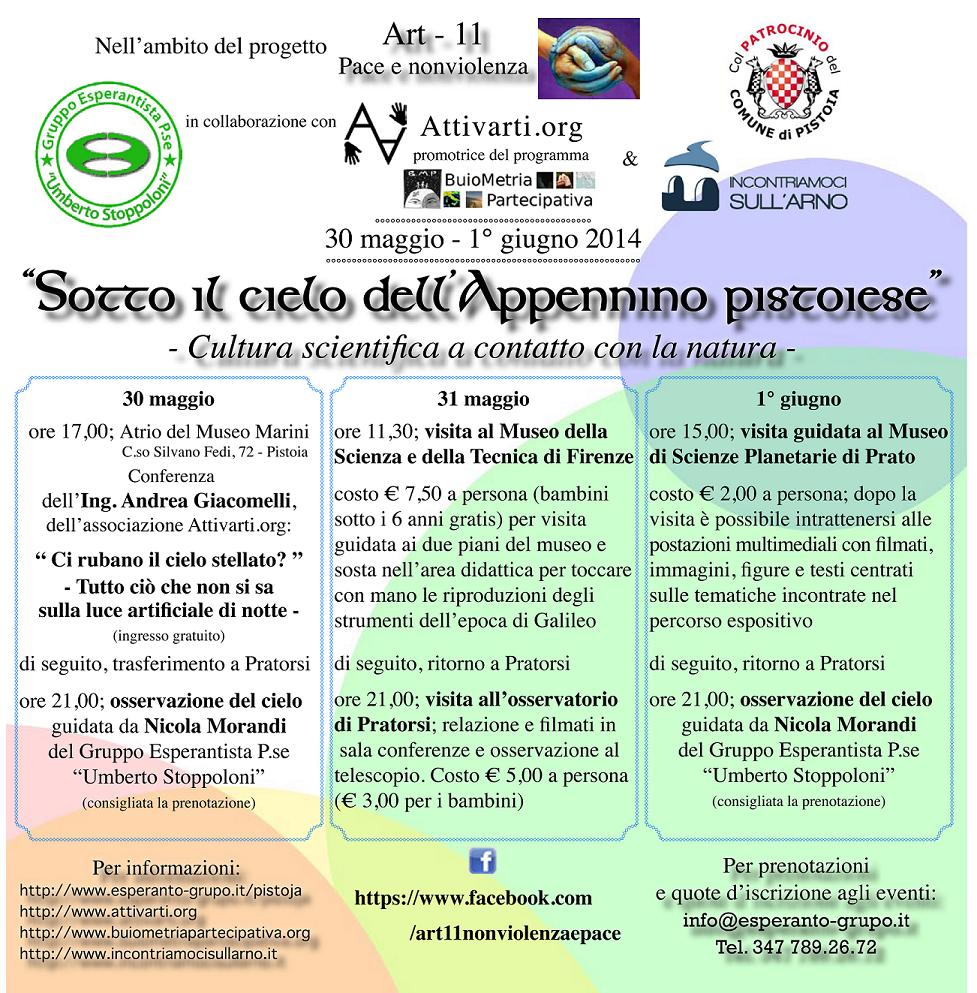
La foto in testa all’articolo è di Michele La Micela ed è tratta dal concorso Fra il Tramonto e l’Alba
[NOTE: all links below refer to pages in Italian. For more information in English please write to info@pibinko.org]
The project was launched in public on March 6, 2014, and was wrapped up with a debriefing and a demonstration at Caffé Ricasoli in Grosseto.
All details on the story about palla 21 and Milano are on www.palla21.it